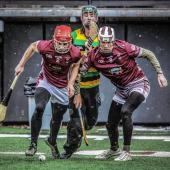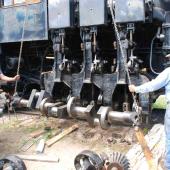Evel Knievel's Shooting Star
The legacy of a Butte, Montana native...
“Evel Knievel: Explorer, Mortorcyclist, and Daredevil.” These words, engraved in a 3,000 pound marker donated to commemorate Evel Knievel’s 1975, spectacular, yet failed, attempt to soar over 1,300 feet across the Snake River Canyon, tell us what Knievel did for a living but certainly falls far short of telling us who he was. With his image in his Liberace-inspired, signature red, white, and blue leather jumpsuit and capeand his strength of will, Evel Knievel embodied the America spirit—the idea that when you fail you pick yourself up and try again next time.

In his version, however, the “next time” increased in complexity, size, and danger, breaking his personal boundaries and extending himself just a little bit beyond his current capabilities. As a pioneer of extreme sports, Knievel was very successful, but it was almost his failures more than his successes that people came to appreciate. His ability to rise up and shake the dust off from body-crunching crashes endeared him to his public and emblazoned him in history. He was once quoted as saying that if he didn’t crash he wasn’t trying hard enough—where was the excitement if there was a 90% chance of success?
Born Robert Craig Knievel on October 17th, 1938, Evel Knievel gave the nation something to believe in at a time when we were having trouble believing in ourselves. He was born during the beginning of the end of the boom times for Butte, Montana. He rose to fame at the height of the anti-war movement in 1967, and his career flourished in the 1970s during hard times for the nation, including the Robert Kennedy and Martin Luther King assassinations, the Vietnam War, and Watergate. “America was kind of down on itself, uncertain,” says Pat Williams, Evel Knievel’s cousin, former U.S. Representative for Montana, and current Senior Fellow at U of M’s Center for the Rocky Mountain West. “Here was this guy charging over cars and canyons and his can-do attitude struck people. I think he always thought that he caught a wave.”
His life mirrored these tumultuous times, rising from the dust mined in his back yard, becoming an international star, intermixed with occasional run-ins with the law, bankruptcy, brawls, undaunted bouts of charity intermixed with lawsuits, and those terrible accidents. Multiple hospital stays claimed over three years of his life; he accumulated so many broken bones that he held the Guinness World record for the most broken bones suffered by a single body (over 400). “He was a very determined, complex, and charismatic individual,” says his son, Kelly Knievel, “He created Evel Knievel and once he became Evel Knievel he had to maintain and constantly top himself. He must have got a lot out of it because it came with a heavy price.” Kelly remembers his father’s confidence and determination in his ability though it was tempered by knowledge of his own limitations. “He would often say to me—‘What am I going to do, give them their money back? This is what they’ve paid to see me do,’” says Kelly, who attended and crewed many of his father’s jumps when he was younger. Knievel himself once said that though he created the character called Evel Knievel, it sort of got away from him.
His legendary name, so the story goes, was the outcome of sharing a jail cell with an inmate with the moniker “Awful Knawful.” He often ended up in jail for reckless driving and once doused the lights of Butte after a daredevil stunt with an earthmover. Given Bobby’s numerous, some innocent and a few not so innocent pranks, the night jailor, familiar with his charge, completed roll call with “Evil” rather than “Bobby” Knievel. A marketing genius, even as a youngster, Knievel changed the spelling and a legend was born.
“As a kid he was a daredevil, as far back as I can remember,” says Williams; “by this I mean he was just a devil as a kid. If you dared him to do something, hell, he’d go do it. He was an incredible athlete, but the secret about Bobby Knievel was how damn intelligent he was.”
His early athletic accomplishments included winning the Northern Rocky Mountain Ski Association Class A Men’s Ski Jumping Championship and playing minor league pro-hockey. Playing on someone else’s team, under someone else’s rules was not Knievel’s style. He soon left to start his own semi-pro-hockey team back in Butte called the Butte Bombers. The hockey team was short-lived following an unfortunate incident after playing the 1960 Olympic Czechoslovakian team. (Something about missing receipts.)
This combination of smarts, athleticism, and fearlessness formed the base of his later career. When you add his fierce individualism, a typical Butte attribute, you begin to get a sense for what made Bobby, Evel Knievel.
“He was going to be someone,” says Kelly. “That’s what started him down this path. In Butte at that time, not many graduated from college. It was his belief in himself and his confidence in his ability that captured our imagination. It was not premeditated. If it wasn’t motorcycles, it would have been something else.” One of Knievel’s first professional jumps at age 27 cleared a number of mountain lions although his back wheels reportedly bumped the box of snakes. He jumped through firewalls, styling his initial shows after an earlier auto daredevil by the name of Joey Chitwood. He quickly outgrew these stunts and just one year later, in 1966, he began dreaming of jumping the Grand Canyon. In November of that year, he chose his spot on the Navajo Reservation, though this jump never happened. It was not a dream given up on easily and one that spurred another just a few years later. As spectacular as this jump would have been, Knievel set up several events in 1967 that not only put him on the map but also catapulted him into worldwide fame.
He set the stage to jump over 16 cars at three different venues; the first one successful while the next two ended up in progressively more serious bodily injuries. Injuries aside, later that year this constant promoter and consummate deal-maker talked Caesar’s Palace in Las Vegas into letting him jump over the fountains adorning the outside of their famous hotel. Knievel reportedly had the event filmed by John and Bo Derek. After his crash, ABC-TV bought the rights to the film, serving to boost his worldwide persona and spurring him on to more daring stunts.
“Nobody did what he did,” says Williams. “There were lots of kids with broken ankles and legs trying to jump over ramps ,but there was no one as good as Bobby at jumping over long distances.” The longest distance Knievel attempted was on his famed jet-powered motorcycle across Shoshone Falls of the Snake River Canyon in Twin Falls, Idaho. Knievel made an indelible mark on this small town community, bringing fame, fortune, lawsuits, brawls, and drama. His closest friends and family peered deep into the canyon fearing the worst as the malfunctioning sky-cycle missed its mark; yet Knievel walked away with hardly a scratch. In the following years, he would not be so lucky. Throughout the rest of the 1970s Knievel went back to jumping man-made objects, moving from cars to buses, both in the U.S. and Britain. Throughout the rest of his daredevil life, he broke personal records for distance, crowds, and personal body parts.
During his career, he revved up for over 300 death-defying jumps and though it is the crashes we remember best, his success rate was over 95%. His success crossed over into movies; three were made of his life and he actually starred in one of them. He also made millions on promotional sponsorship, endorsements, his relationship with the Ideal toy company, comic strips, and even a rock opera. But this rough and tumble kid from Butte didn’t live life in a straight line. By the early 1980s he was facing financial and legal problems. In 1983, he described himself as “...busted, disgusted, can’t be trusted.” During a short stint in jail for assaulting one of his previous associates, Knievel lost his toy contract but gained kudos with his cellmates for providing limo rides for work duty. Knievel picked himself up and by the 1990s enjoyed a resurgence in popularity and promotional contracts.
The man lived life much like his jumps—on the edge. Just a few short years later, he was diagnosed with hepatitis C contracted from one of his hospital encounters. Again, Knievel picked himself up and charged on. His ability to move people and inspire them to catch his wave was no more apparent than in 2007 during his televised conversion to Christianity, which sparked an almost spontaneous response—some Christian leaders cited the outpouring as a religious awakening and spiritually significant event.
Knievel died a few short months later on November 30, 2007, at the age of 69 from idiopathic pulmonary fibrosis. “In the end he had a perspective on life and it really had to do with his failing health,” says Williams. “He was unwilling to give up. He knew he was in terrible trouble with his health and he was angry about it. Bobby always held up hope that he would be okay again. He’d broken so many bones and had so much metal in his body, he’d survived all that and in the end he felt he’d been shortchanged by his illness.”
The rascal of Butte may not have been universally loved but he was a man who carved out a place in our psyche about what it is to be an American. He wore the badge and illuminated what it is we love best about our country and our drive to succeed against all odds.
“He made a few mistakes along the way,” says Kelly, “but I think people need to remember his inspirational successes.”
~ Kim Thielman-Ibes, a third generation Montanan hailing from the Hi-Line, is a freelance writer living in Bozeman. She obtained her undergraduate degree from the University of Montana and her MBA from Seattle University. After 14 years of working in corporate sales she, her husband, and precocious cat moved back to Montana to write, play, and live. In 2002, Kim published her first nonfiction book, Where the Hardwood Draws.












Leave a Comment Here